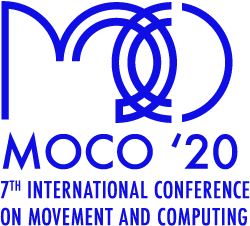Detailed SESSION INFORMATION
JULY 17,2020: 9:45-10:45 PM EDT (UTC -4)
Lament: An Interactive Cabaret Song
Courtney Brown
ABSTRACT
+
Lament is an interactive cabaret song in which skeletal upper body motion capture of the vocalist drives musical outcomes. The cabaret context in part drives the musical content of the work, which draws from popular, experimental, and minimalist musical traditions. The performer movements are influenced by both flamenco and Argentine tango dance technique, but are representative of neither. While some melodic and harmonic content is fixed, the system employs machine learning techniques to generate melodies in real-time. Other harmonic and melodic content is determined by the relationship between one part of the performer’s body and another.musical traditions. The performer movements are influenced by both flamenco and Argentine tango dance technique, but are representative of neither. While some melodic and harmonic content is fixed, the system employs machine learning techniques to generate melodies in real-time. Other harmonic and melodic content is determined by the relationship between one part of the performer’s body and another.
VIDEO
Hybrid Violin Performance: Model-Free, Abductive Experiment
Seth Thorn
ABSTRACT
+
My augmented violin is a personal instrument consisting of an acoustic violin, realtime signal processing, a custom sensor glove, and a violin shoulder rest embedded with voice coils for haptic feedback. Feature construction in software is not model-based but built by abductive experimentation—continuously refined by trial and error. My approach to movement analysis is not based on classifying formalized styles of bowing but on continuous tracking of non-tokenized movement and gesture. These techniques are co-developed with novel sonification methods ad libitum, conditioning the performance media without schematizing possible gestures a priori. Furthermore, ongoing development of the instrument, which includes novel haptic feedback elements, effectively symmetrizes sensory feedforward and feedback paths—the enactive loop between action and perception—yielding refined instrumental dynamics, yet the signal processing decisions entail no claim to universality or scientific validity. I improvise with this instrument in live performance, unfurling its possibilities and resingularizing my technique.
Portable Interactive Explorations of Motion Data Systems for Choreographers
Zjana Muraro and Colin Higgs
ABSTRACT
+
We present a mocap system designed with an aim towards understanding and incorporating the needs of contemporary dance choreographers and their integral relationship to somatics into interdisciplinary performance. Somatics here refers to the use of specific images and sensorial cognizance of physics principles in the human body which inform how the movement is created and performed. We apply these same somatics elements to the computational design and share the current state and our preliminary findings and results in using the system for a variety of site-specific dance performances.
Action Camera Choreography: Generative Movement in Non-Space
Linda Ryan
ABSTRACT
+
Action Camera Choreography is an artistic practice that utilizes wearable technology (primarily, but not limited to, action cameras) in dance. It produces a simultaneous physical and virtual performance that blends live performance and live video. This exposes an innate tension in dance/technology work: that a physical body, when coerced to a non-physical medium, is both more and less intimate than its physical counterparts. In contrasting both iterations of embodiment (the physical and the non-), the practice attempts to reconcile this tension and directly involve the viewer in the act of resolution – or, barring this, a recognition that the juxtaposition exists at all.
Action Camera Choreography has been used in 6 performances and 2 teaching series in the last 2 years, engaging audiences and prompting introspection to the way one interacts with technology, intimacy, and personhood in performance settings and daily life. More work is needed to pinpoint the specific successes and failures of the methodology as an iterative artistic practice, teaching tool, and performance series. Future sub-topics of interest include the role of the observer in either differentiating or synthesizing the physical and digital components; and the implications of visibility in reference to certain performers (e.g. queer bodies).
Movement computation and analysis for entrainment in the rhythms of Bharatanatyam
Calai Chandrasekaram and Lasantha Chandana Goonetilleke
ABSTRACT
+
Computational video analysis methods based on direct synchronization between the dance-beat and the music-beat consider many natural movements irregular and nondancelike. We will give examples, through performances as well as through mathematical and computational analysis, to show that such "singularities" can be "smoothly continued" by improvisations afforded through the rich structure of rhythm in Carnatic music and Bharatanatyam dance.

